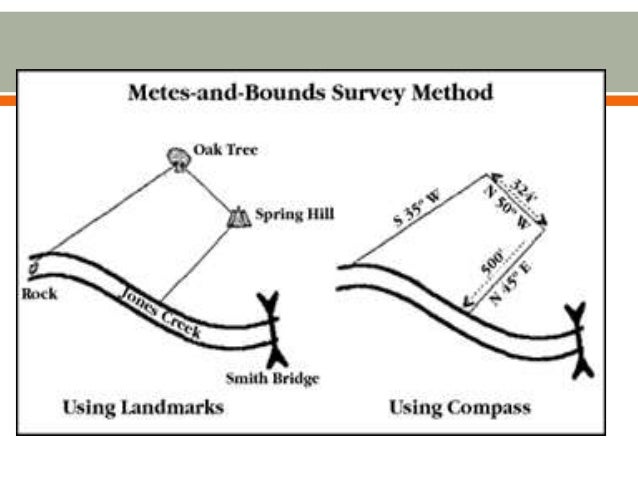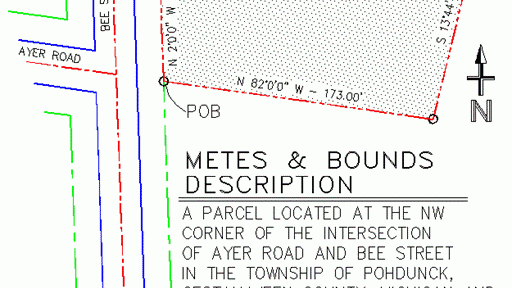

To measure distances, the lead chainman walked toward the mark that the surveyor had determined with his compass. At other times, an offset line might be surveyed to avoid a major obstacle, with the "straight" line between two points calculated later. If the bearing determined by the surveyor required travel on a physically difficult path, then the line might veer slightly. Streams, swamps, cliffs, and other obstructions were challenges for chainmen pulling poles 66' forward to maintain a straight line. Pulling the chain involved travel through rough country under difficult conditions, and a half-chain only 33' long was commonly used in Virginia.
#Metes and bounds system how to
Part of the surveyor's skill was knowing how to adjust compasses, based on star and sun sightings, to determine magnetic north at each location. If in a hurry, or if interested in enclosing "surplus" acreage beyond what was authorized, surveyors could speed up their field work at the price of accuracy.Ĭompasses were instruments based on magnets, and some were more accurate than others. To improve accuracy, surveyors were trained to "backsight" from the forward end of the chain to verify the bearing was consistent. Source: Colorado Department of Transportation, Basic Surveying Modern surveyors use metal tapes - and electronic distance measuring technology - rather than chains with links to measure distance This process would be repeated until returning to the point of beginning, with trees marked at each change in direction to define the boundary. The surveyor would use the compass to determine the change in angle to define the next bearing, and the chain would be pulled in that new direction the appropriate distance.
#Metes and bounds system full
The chain would be stretched the full length, then the poles moved to stretch the chain forward again until reaching the end of the line in that one direction. Assistants would cut a straight line through the woods and stretch a chain of a known length along that line, following the bearing determined by the surveyor. Surveyors would move away from a recognizable starting point, using a compass to determine the direction in which they were moving. Instead, surveyors were directed to define polygons that enclosed high-quality land for farming and excluded areas with poor soil. Other than town lots in places such as Williamsburg and Alexandria, Virginia landowners rarely purchased property defined by rectangles. A chain stretched out 10 times in one direction (600 feet) and once in the other direction (66 feet) would define a rectangle enclosing one acre. A chain stretched to its length 80 times would define the length of a mile. A Gunter chain was 66 feet long, and each of the 100 iron links in that chain was 66/100 of a foot (7.92 inches) in length. The units were traditional English measures, with land measured by the acre (43,560 square feet). Surveying in Virginia was not based on the metric system. Chains and compasses were used to mark lines from a starting point, typically a natural feature such as a large white oak tree.

Source: Library of Congress, George Washington survey - Plat of survey for John Lindsey of 223 acres in Frederick County, Vaįrom colonial times, individual Virginia properties were surveyed according to the metes and bounds system. Simple rectangular metes and bounds survey in Shenandoah Valley, 1750 Surveying in Virginia Surveying in Virginia


 0 kommentar(er)
0 kommentar(er)
